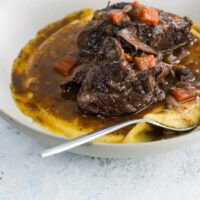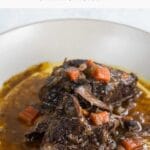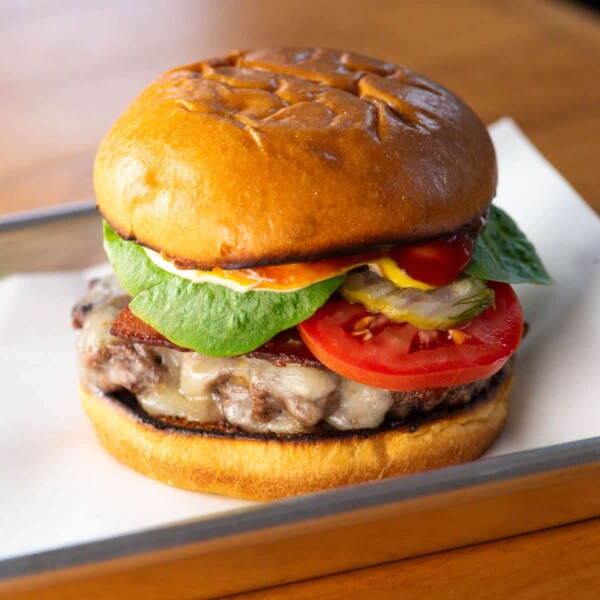This post may contain affiliate links. Learn more.
Here’s how to cook beef short ribs when you’re in the mood for beautiful, gently sophisticated comfort food that’s perfect for a dinner party.

Why we love this recipe
Braised short ribs have the best vibes. They’re totally unpretentious, yet they pack a nuanced, sophisticated flavor punch thanks to a low and slow steep in a veggie- and wine-infused sauce.
This recipe:
- Is a favorite for holidays and dinner parties — it makes guests feel well taken care of without any expectations
- Brims with deep, satisfying flavors and melting tenderness
- Doesn’t require any special skills to create something truly special
- Makes a big batch, or halve it without making any additional changes to the method
- Can be cooked in advance and finished shortly before serving
What you’ll need
Here’s a glance at the ingredients you’ll need to make this recipe.

- Beef short ribs are cut from the lower part of a cow’s ribcage, behind the brisket. The heavily marbled meat sits atop a piece of bone. You’ll find them cut in various sizes. For a recipe like this it doesn’t matter too much. These are English-cut, about four inches long and two inches wide, which works perfectly.
- I’ve pictured a nicer dry red wine here than you need, just because it’s what I had on hand. Most recipes will insist you use a full-bodied variety like cabernet sauvignon or shiraz, and you’re welcome to. I find that lighter reds work beautifully as well. Virtually all of the alcohol cooks off during the long braising, so there’s no need to worry about alcohol content in the final dish. The flavors concentrate as the liquid reduces, so choose something you like the taste of.
- Lower-sodium beef broth adds plenty of flavor and lets you control the salt levels in the final dish, which also concentrate as the sauce reduces.
- Herbes de Provence add the perfect subtle flavor to this classic recipe. Blends vary but usually contain some combination of savory, marjoram, rosemary, thyme, oregano, and lavender.
- At the end of the cooking process, you’ll mix a bit of all-purpose flour with some of the sauce to form a slurry, then stir it into the sauce and simmer to thicken. To make this recipe gluten-free, simply swap in a 1:1 GF flour blend.
My favorite sources for meat & pantry staples
For years, I’ve been sourcing our meat from ButcherBox. We love this curated meat delivery service, which provides grass-finished beef, heritage breed pork, organic chicken, and more from small farms direct to the customer. You can learn more in my extensive Butcher Box review and unboxing.
I love Thrive Market for a wide variety of products. Often described as one part Whole Foods, one part Costco, they’re a membership-based online market for healthier products at discounted prices. Plus, they’re mission-driven, engaged in the community, and not currently owned by a giant corporation. You can learn more in my Thrive Market review and unboxing.
How to make it
Here’s an overview of what you’ll do to make a gorgeous batch of braised short ribs. You can see the steps in action in the video that accompanies this post, and get all the details in the recipe card below.

- First you’ll brown the short ribs in uncrowded batches.
- Cook the vegetables and create the sauce.
- Transfer the stew to the oven to slow-cook for about three hours.
- Thicken the sauce and serve.
Expert tips and FAQs
I’ve pictured braised short ribs here served over cheddar polenta, and you can’t beat that. Mashed potatoes (basic or boursin) work beautifully, as would mashed cauliflower.
A bottle of red wine and a simple green salad round out the meal.
Yes. I actually prefer to do the braising a day in advance when possible, let them cool, and refrigerate. Short rib has a very high fat content, which ends up in the sauce. By chilling overnight, you let a lot of the fat rise to the surface and solidify, which makes it easy to remove before reheating and thickening the sauce. You’ll still end up with a rich and indulgent dish.
Leftovers keep well in an airtight container in the fridge and can be reheated on the stovetop or in the microwave. Or freeze for up to a year.
More favorite low & slow meats

Hungry for more?
Subscribe to Umami Girl’s email updates, and follow along on Instagram.

How to Cook Beef Short Ribs
Equipment
Ingredients
- 8 pounds 3(629 grams) bone-in beef short ribs
- 1 teaspoon fine sea salt
- ½ teaspoon freshly ground black pepper
- 1 large onion, 250 grams, diced
- 2 medium carrots, 200 grams, diced
- 2 ribs celery, 200 grams, diced
- 8 cloves garlic, chopped
- 2 tablespoons tomato paste
- 1 750- ml bottle dry red wine
- 4 cups reduced-sodium beef broth
- 2 teaspoons herbes de Provence
- 2 bay leaves
- ¼ cup (30 grams) flour
Instructions
- Sprinkle the short ribs evenly with the salt and pepper.
- Heat a very large Dutch oven (I use my 9-quart Le Creuset) over medium-high on the stovetop.
- In uncrowded batches, add the short rib and brown thoroughly on all sides. Remove to a plate.
- If there is more than about two tablespoons of fat in the pan, remove it. Reduce heat to medium.
- Preheat oven to 325°F with a rack in the lower third.
- Add onion, carrot, and celery to the pot and stir to coat with the fat.
- Cook, stirring occasionally, until the vegetables have released the browned bits from the bottom of the pan and are starting to soften.
- Add the garlic and tomato paste and cook, stirring, for one minute.
- Pour in the wine and the broth and add the herbes de Provence and the bay leaves.
- Bring to a boil.
- Add the meat and any accumulated juices back to the pan, nestling it in so it's covered as much as possible by the liquid.
- Cover and transfer to the oven to cook for about three hours, until meat is fork-tender and easily falls off the bone.
- If possible, at this stage I like to let the whole thing cool and refrigerate it overnight. This allows much of the substantial fat content of the sauce to rise to the surface and solidify, making it easy to remove. The dish will still be amply rich, but the sauce won't be greasy. If you don't have time for this step, skim off as much of the liquid fat from the sauce as possible before proceeding.
- Remove beef from pot and set aside. It's traditional to make an attempt to keep the bones loosely attached to the meat for serving, but I find they often fall off. When this happens I remove and discard the bones, and no one minds. You can choose what to do.
- Remove and discard bay leaves.
- Place the flour into a small mixing bowl. Spoon out enough of the sauce to mix with the flour and create a smooth paste.
- Place the pot over medium-high heat on the stovetop. Whisk in the flour mixture.
- Bring sauce to a boil, reduce heat, and simmer for about five minutes, until thickened.
- Return beef to pot to coat with sauce.
Notes
- Beef short ribs are cut from the lower part of a cow's ribcage, behind the brisket. The heavily marbled meat sits atop a piece of bone. You'll find them cut in various sizes. For a recipe like this it doesn't matter too much. These are English-cut, about four inches long and two inches wide, which works perfectly.
- I've pictured a nicer dry red wine here than you need, just because it's what I had on hand. Most recipes will insist you use a full-bodied variety like cabernet sauvignon or shiraz, and you're welcome to. I find that lighter reds work beautifully as well. Virtually all of the alcohol cooks off during the long braising, so there's no need to worry about alcohol content in the final dish. The flavors concentrate as the liquid reduces, so choose something you like the taste of.
- Lower-sodium beef broth adds plenty of flavor and lets you control the salt levels in the final dish, which also concentrate as the sauce reduces.
- I've pictured the short ribs here served over cheddar polenta, and you can't beat that. Mashed potatoes (basic or boursin) work beautifully, as would mashed cauliflower. A bottle of red wine and a simple green salad round out the meal.
- To make this recipe gluten-free, simply swap in a 1:1 GF flour blend.
- Leftovers keep well in an airtight container in the fridge and can be reheated on the stovetop or in the microwave. Or freeze for up to a year.
Nutrition
Nutrition information is automatically calculated, so should only be used as an approximation.
Hungry for more?
Subscribe to Umami Girl’s email updates, and follow along on Instagram.












